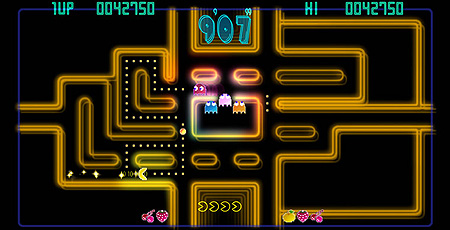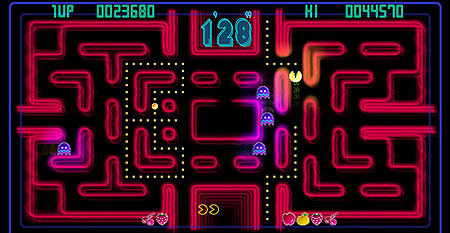I, like many children in the 80s, grew up surrounded by Pac-Man paraphernalia. Each week I'd wake up and eat breakfast while staring at my Pac-Man placemat, drink my cranberry juice from a Pac-Man mug, then watch the Pac-Man Saturday morning cartoon show. Why? I loved the game's aesthetic, specifically the evocative simplicity of the characters, the mesmerizing trail of dots, and the intricate overhead view of the mazes. However, when it came to playing the game I was a complete clod. I'd wander around aimlessly, lacking any sort of strategy, occasionally chewing away at pellets but mostly running away from the ghosts, maybe lasting a few boards at best before wasting all my lives. Without a tangible target I spent most of the game fearing Inky, Pinky, Blinky and Clyde and staring at the void left by Pac-Man's insatiable appetite, instead of tactically munching away.
Needless to say, this lack of focus is why I fail to excel at many arcade games but, thanks to their brief playing time (well, at least by my hands), I've endlessly pursued them, snacking away in arcades like one would a tasting menu. Sample a few bites with friends, chew over the flavors and textures and then quickly move along to the next.

Unlike the original, Namco Bandai's Pac-Man Championship Edition (Pac-Man C.E.) primary mode forces me to adapt my ways: it sets a time limit, one that seems quite realistic, and starts at an almost languid pace. I have an objective to aim for: live for five minutes, by any means possible.
And, initially, it seems extremely attainable. Then the ghosts start speeding up, my Power Pellet time diminishes drastically, and the amount of pellets necessary to eat and regenerate half of the board increases. By then I'm frantic to clean out each half, to get more fruit, get more power pellets, eat more ghosts, gain more points, to prosper as much as I can before my time comes to an end. All of the sudden an ill-timed death becomes a matter of inconvenience as opposed to utter mortality, a time-based bloodletting, merely inhibiting you from consuming more and ratcheting up your score. It's all a matter of time, time, time, there's not enough time to accomplish what I want! The music builds, the ghosts' pace escalates, you watch their trails in-between score glances and then...

It's over. Now that the burden of time has been forcefully imposed on me I'm able to focus, to start seeing patterns, to start thinking tactically. And when I restart the game to apply what I've learned, my movements feel so sluggish, bogged down as I try to acclimate to the initial pacing. The rush starts to quickly build anew as the game picks up, and I start sneaking peaks at my score again, start adjusting my play style until, all of the sudden, it's all over, again. And yet again, I'll use these newfound skills to persevere in subsequent attempts, challenges and extra modes, even as the maze walls shift and change in front of my very eyes and the ghosts drift at previously unheard of speeds.
While the original Pac-Man gave me more control over Pac-Man's mortality, I had no idea what to do with it. Now that Pac-Man C.E. has lifted that burden from my shoulders, I feel like I have more direction in its hallowed maze walls – I can focus on the task at hand. While it's doubtful that my scores will ever be recorded on the C.E. leaderboards, I'll continue to return to the game with purpose and ambition instead of apathy and ambivalence. It has taken over twenty years, but finally I enjoy playing the game as much as I enjoyed my Pac-Man placemat.



